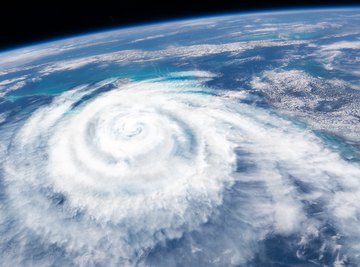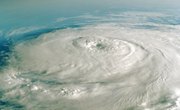
Hurricanes, known as typhoons when they appear west of the International Date Line and as tropical cyclones more generally, are extremely powerful storms that form over the Earth's oceans. They originate over warmer waters and hence form close to the equator, where ocean and air temperatures tend to be highest. In fact, for these storms to form at all, the water temperature must be 80 degrees Fahrenheit or warmer throughout the first 50 meters below the surface. This is why a major concern regarding global warming is an increase in hurricanes: If more of the Earth's waters are above a critical temperature threshold, the chance of a cyclone appearing anywhere on the planet is higher.
Initial Hurricane Formation
According to the SciJinks website concerning how a hurricane forms, moisture that evaporates from the ocean waters in high-temperature areas in the tropics (i.e., within about 23 degrees of the equator) has a tendency to cluster into distinct shapes, owing to the fact that warmer air is capable of holding more moisture than cooler air. Wind catalyzes this process by sweeping the water vapor from the surface and collecting it into distinct pockets. As the moist air rises, it begins to twist as a result of the Earth's rotation and gravitational forces.
Owing, again, to temperature-related factors, hurricanes form most readily in the late summer and early autumn.
Geographical Particulars
Storms that form north of the equator are identical at a glance to those that originate in the Southern Hemisphere. However, hurricanes that form in northern latitudes rotate in a counterclockwise direction, whereas those that form south of the equator spin clockwise.
Hurricanes that form in the Atlantic off the western coast of Africa are blown in the direction of North America by prevailing winds out of the east (i.e., winds blowing west). This is why, when you watch or read the news, almost every hurricane that threatens the U.S., the Caribbean islands or Mexico approaches from the so-called Atlantic basin. West-blowing winds, the tiny, highly populated Caribbean islands, and thickly settled East Coast U.S. states combine to form a perfect hurricane recipe for disaster.
Storms that form off the western U.S. coast also tend to move west and hence away from the American mainland, in part explaining why they are not as common or damaging a phenomenon.
NOAA Hurricane Classification
Most potential hurricanes never reach the level of a dangerous storm or attract any attention at all outside of the meteorologists who specifically monitor hurricanes. At the lowest level, a tropical disturbance might result in some unruly thunderstorm clouds. A tropical depression involves circulating winds of 25 to 38 miles per hour and results from the warm air released at the top of am atmospheric hurricane column cooling, falling, reheating and rising again as winds pick up. At a wind speed of 39 miles per hour, the system becomes a tropical storm and is given an official name such as Harvey or Irma. Finally, when winds top 74 miles an hour, the storm is officially a tropical cyclone (or hurricane, in current parlance) according to the National Oceanic and Atmospheric Administration (NOAA).
References
Resources
About the Author
Kevin Beck holds a bachelor's degree in physics with minors in math and chemistry from the University of Vermont. Formerly with ScienceBlogs.com and the editor of "Run Strong," he has written for Runner's World, Men's Fitness, Competitor, and a variety of other publications. More about Kevin and links to his professional work can be found at www.kemibe.com.
